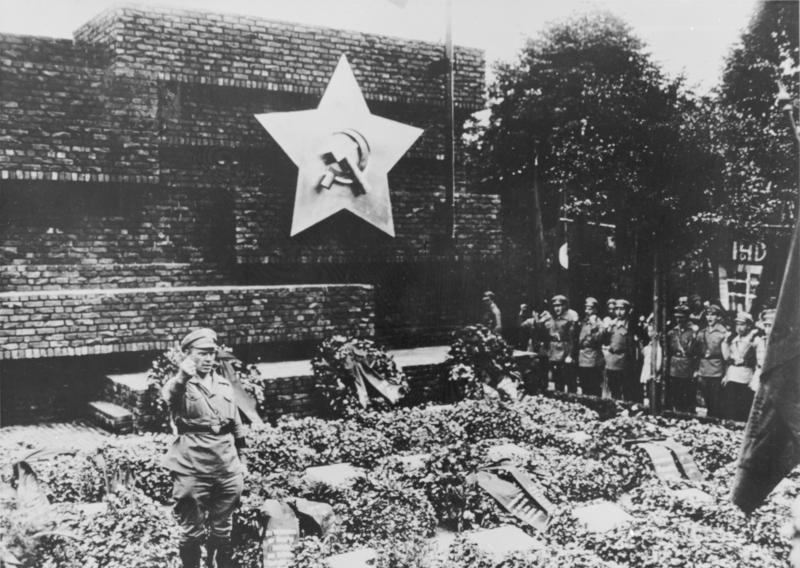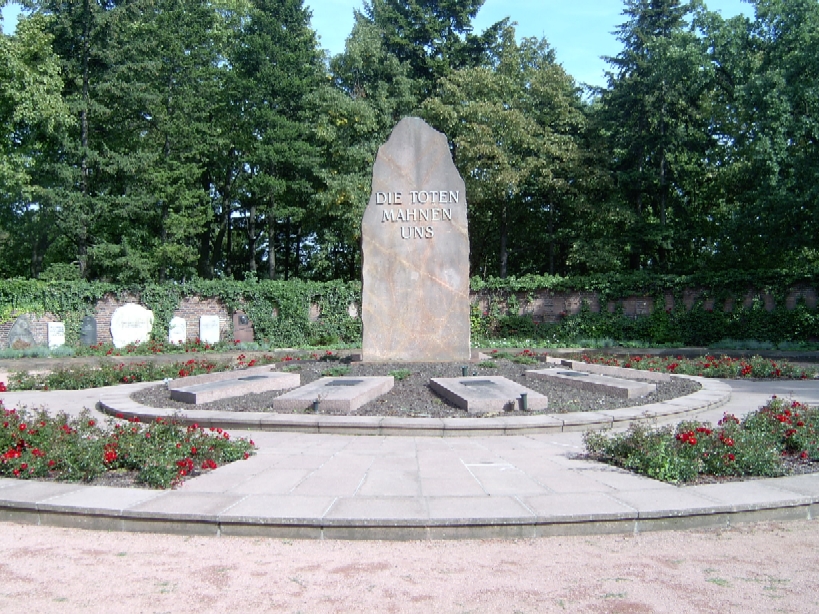Zentralfriedhof Friedrichsfelde on:
[Wikipedia]
[Google]
[Amazon]



 The Friedrichsfelde Central Cemetery (german: Zentralfriedhof Friedrichsfelde) is a
The Friedrichsfelde Central Cemetery (german: Zentralfriedhof Friedrichsfelde) is a



 The Friedrichsfelde Central Cemetery (german: Zentralfriedhof Friedrichsfelde) is a
The Friedrichsfelde Central Cemetery (german: Zentralfriedhof Friedrichsfelde) is a cemetery
A cemetery, burial ground, gravesite or graveyard is a place where the remains of dead people are buried or otherwise interred. The word ''cemetery'' (from Greek , "sleeping place") implies that the land is specifically designated as a bu ...
in the borough
A borough is an administrative division in various English-speaking countries. In principle, the term ''borough'' designates a self-governing walled town, although in practice, official use of the term varies widely.
History
In the Middle Ag ...
of Lichtenberg
Lichtenberg () is the eleventh borough of Berlin, Germany. In Berlin's 2001 administrative reform it absorbed the former borough of Hohenschönhausen.
Overview
The district contains the Tierpark Berlin in Friedrichsfelde, the larger of Berlin ...
in Berlin
Berlin ( , ) is the capital and largest city of Germany by both area and population. Its 3.7 million inhabitants make it the European Union's most populous city, according to population within city limits. One of Germany's sixteen constitu ...
. It was the cemetery used for many of Berlin's Socialists
Socialism is a left-wing economic philosophy and movement encompassing a range of economic systems characterized by the dominance of social ownership of the means of production as opposed to private ownership. As a term, it describes the econ ...
, Communists
Communism (from Latin la, communis, lit=common, universal, label=none) is a far-left sociopolitical, philosophical, and economic ideology and current within the socialist movement whose goal is the establishment of a communist society, a s ...
, and anti-fascist fighters.
History
When the cemetery was founded in 1881 it was called the Friedrichsfelde Municipal Cemetery Berlin (german: Berliner Gemeindefriedhof Friedrichsfelde). In 1900, with the burial ofWilhelm Liebknecht
Wilhelm Martin Philipp Christian Ludwig Liebknecht (; 29 March 1826 – 7 August 1900) was a German socialist and one of the principal founders of the Social Democratic Party of Germany (SPD).Social Democratic Party (SPD), the cemetery became the resting place for many of the leaders and activists of Germany's social democratic, socialist and communist movements. In 1919,
File:Tombstone Kaethe Kollwitz.jpg,
(
Karl Liebknecht
Karl Paul August Friedrich Liebknecht (; 13 August 1871 – 15 January 1919) was a German socialist and anti-militarist. A member of the Social Democratic Party of Germany (SPD) beginning in 1900, he was one of its deputies in the Reichstag fro ...
and Rosa Luxemburg
Rosa Luxemburg (; ; pl, Róża Luksemburg or ; 5 March 1871 – 15 January 1919) was a Polish and naturalised-German revolutionary socialism, revolutionary socialist, Marxism, Marxist philosopher and anti-war movement, anti-war activist. Succ ...
, co-founders of the Communist Party of Germany
The Communist Party of Germany (german: Kommunistische Partei Deutschlands, , KPD ) was a major political party in the Weimar Republic between 1918 and 1933, an underground resistance movement in Nazi Germany, and a minor party in West German ...
were buried there. A 2009 Charité
The Charité – Universitätsmedizin Berlin (Charité – Berlin University of Medicine) is one of Europe's largest university hospitals, affiliated with Humboldt University and Free University Berlin. With numerous Collaborative Research C ...
autopsy report however cast doubt on whether Rosa Luxemberg was ever buried there.
The division of Berlin
The Berlin Wall (german: Berliner Mauer, ) was a guarded concrete barrier that encircled West Berlin from 1961 to 1989, separating it from East Berlin and East Germany (GDR). Construction of the Berlin Wall was commenced by the governme ...
following the Second World War
World War II or the Second World War, often abbreviated as WWII or WW2, was a world war that lasted from 1939 to 1945. It involved the vast majority of the world's countries—including all of the great powers—forming two opposi ...
caused the cemetery to be within the borders of East Berlin
East Berlin was the ''de facto'' capital city of East Germany from 1949 to 1990. Formally, it was the Soviet sector of Berlin, established in 1945. The American, British, and French sectors were known as West Berlin. From 13 August 1961 u ...
, where it was used to bury East German
East Germany, officially the German Democratic Republic (GDR; german: Deutsche Demokratische Republik, , DDR, ), was a country that existed from its creation on 7 October 1949 until its dissolution on 3 October 1990. In these years the state ...
(GDR) leaders, such as Walter Ulbricht
Walter Ernst Paul Ulbricht (; 30 June 18931 August 1973) was a German communist politician. Ulbricht played a leading role in the creation of the Weimar-era Communist Party of Germany (KPD) and later (after spending the years of Nazi rule in ...
and Wilhelm Pieck, the first President of the GDR.
Architect and future Bauhaus director, Ludwig Mies van der Rohe
Ludwig Mies van der Rohe ( ; ; born Maria Ludwig Michael Mies; March 27, 1886August 17, 1969) was a German-American architect. He was commonly referred to as Mies, his surname. Along with Alvar Aalto, Le Corbusier, Walter Gropius and Frank Lloy ...
designed ''Monument to the Revolution'' in 1926, a wide and high red brick monument which the National Socialists
Nazism ( ; german: Nazismus), the common name in English for National Socialism (german: Nationalsozialismus, ), is the far-right totalitarian political ideology and practices associated with Adolf Hitler and the Nazi Party (NSDAP) in Na ...
destroyed in January 1935.
The monument was replaced in 1951 by the present memorial, the ''Memorial to the Socialists'' (german: Gedenkstätte der Sozialisten). This consists of a central porphyry stele or obelisk with the words ''Die Toten mahnen uns'' (The dead remind us) surrounded by a semi-circular wall into which are set gravestones and urns. Surrounding the central stone are 10 graves commemorating foremost socialist leaders, namely: Karl Liebknecht
Karl Paul August Friedrich Liebknecht (; 13 August 1871 – 15 January 1919) was a German socialist and anti-militarist. A member of the Social Democratic Party of Germany (SPD) beginning in 1900, he was one of its deputies in the Reichstag fro ...
, Rosa Luxemburg
Rosa Luxemburg (; ; pl, Róża Luksemburg or ; 5 March 1871 – 15 January 1919) was a Polish and naturalised-German revolutionary socialism, revolutionary socialist, Marxism, Marxist philosopher and anti-war movement, anti-war activist. Succ ...
, Ernst Thälmann
Ernst Johannes Fritz Thälmann (; 16 April 1886 – 18 August 1944) was a German communist politician, and leader of the Communist Party of Germany (KPD) from 1925 to 1933.
A committed Marxist-Leninist and Stalinist, Thälmann played a major r ...
, Wilhelm Pieck, Walter Ulbricht
Walter Ernst Paul Ulbricht (; 30 June 18931 August 1973) was a German communist politician. Ulbricht played a leading role in the creation of the Weimar-era Communist Party of Germany (KPD) and later (after spending the years of Nazi rule in ...
, Franz Mehring
Franz Erdmann Mehring (27 February 1846 – 28 January 1919) was a German communist historian, literary critic, philosopher, and revolutionary socialist politician who was a senior member of the Spartacus League during the German Revolution of 191 ...
, John Schehr
John Schehr (9 February 1896 - 1 February 1934) was a German political activist who became a Communist Party politician and ultimately, chairman (leader) of the party, following the arrest on 3 March 1933 of Ernst Thälmann. By this time the c ...
, Rudolf Breitscheid
Rudolf Breitscheid (2 November 1874 – 28 August 1944) was a German politician and leading member of the Social Democratic Party of Germany (SPD) during the Weimar Republic. Once leader of the liberal Democratic Union, he joined the SPD in ...
, , and Otto Grotewohl
Otto Emil Franz Grotewohl (; 11 March 1894 – 21 September 1964) was a German politician who served as the first prime minister of the German Democratic Republic (GDR/East Germany) from its foundation in October 1949 until his death in Septembe ...
.
On one part of the surrounding wall is a set of large tablets recording the names of 327 men and women who gave their lives in the cause of fighting Fascism between 1933 and 1945. Included in the list are Hans Coppi
Hans-Wedigo Robert Coppi (25 January 1916 – 22 December 1942) was a German resistance fighter against the Nazis. He was a member of a Berlin-based anti-fascist resistance group that was later called the Red Orchestra by the Gestapo.
Life ...
, Hilde Coppi
Betti Gertrud Käthe Hilda Coppi ( Rake; 30 May 1909 – 5 August 1943), known as Hilde Coppi, was a German communist and resistance fighter against the Nazi regime. She was a member of the anti-fascist resistance group that was later called th ...
, Heinrich Koenen, Arvid Harnack
Arvid Harnack (; 24 May 1901 in Darmstadt – 22 December 1942 in Berlin) was a German jurist, Marxist economist, Communist, and German resistance fighter in Nazi Germany. Harnack came from an intellectual family and was originally a humanist. H ...
, Harro Schulze-Boysen
Heinz Harro Max Wilhelm Georg Schulze-Boysen (; Schulze, 2 September 1909 – 22 December 1942) was a left-wing German publicist and Luftwaffe officer during World War II. As a young man, Schulze-Boysen grew up in prosperous family with two sib ...
, John Sieg
John Sieg (February 3, 1903 – October 15, 1942) was an American-born German Communist railroad worker, journalist and resistance fighter, who publicized Nazi atrocities through the underground Communist press and fought against National Soci ...
, and Ilse Stöbe
Ilse Frieda Gertrud Stöbe (17 May 1911 – 22 December 1942) was a German journalist and anti-Nazi resistance fighter. She was born and died in Berlin.
Life
Ilse Stöbe grew up in a working-class home in Berlin. Stöbe was the only daughter of ca ...
.
Notable interments
Gallery
Käthe Kollwitz
Käthe Kollwitz ( born as Schmidt; 8 July 1867 – 22 April 1945) was a German artist who worked with painting, printmaking (including etching, lithography and woodcuts) and sculpture. Her most famous art cycles, including ''The Weavers'' a ...
File:Berlin Friedrichsfelde Zentralfriedhof, Pergolenweg - Benjamin.jpg, Hilde Benjamin
File:Erich Mielke - Zentralfriedhof Friedrichsfelde - Mutter Erde fec.jpg, Erich Mielke
Erich Fritz Emil Mielke (; 28 December 1907 – 21 May 2000) was a German communist official who served as head of the East German Ministry for State Security (''Ministerium für Staatsicherheit'' – MfS), better known as the Stasi, from 1957 u ...
(
unmarked grave
An unmarked grave is one that lacks a marker, headstone, or nameplate indicating that a body is buried there. However, in cultures that mark burial sites, the phrase unmarked grave has taken on a metaphorical meaning.
Metaphorical meaning
As a ...
)
File:Friedrich archenhold grave.jpg, Friedrich Simon Archenhold
Friedrich Simon Archenhold (2 October 1861 in Lichtenau, Westphalia – 14 October 1939 in Berlin) was an astronomer who founded the Treptow Observatory (today the Archenhold Observatory) in Berlin-Treptow. He graduated from the Realgymnasium ...
File:Berlin Friedrichsfelde Zentralfriedhof, Pergolenweg - Fuchs.jpg, Klaus Fuchs
Klaus Emil Julius Fuchs (29 December 1911 – 28 January 1988) was a German theoretical physicist and atomic spy who supplied information from the American, British and Canadian Manhattan Project to the Soviet Union during and shortly af ...
File:B-Friedrichsfelde Zentralfriedhof 03-2015 img33 Konrad Wolf.jpg, Konrad WolfMarkus Wolf
Markus Johannes Wolf (19 January 1923 – 9 November 2006), also known as Mischa, was head of the Main Directorate for Reconnaissance (), the foreign intelligence division of East Germany's Ministry for State Security (, abbreviated MfS, common ...
References
External links
{{Coord, 52, 30, 56, N, 13, 30, 38, E, region:DE-BE_type:landmark, display=title East Berlin Cemeteries in Berlin Buildings and structures in Lichtenberg 1881 establishments in Germany